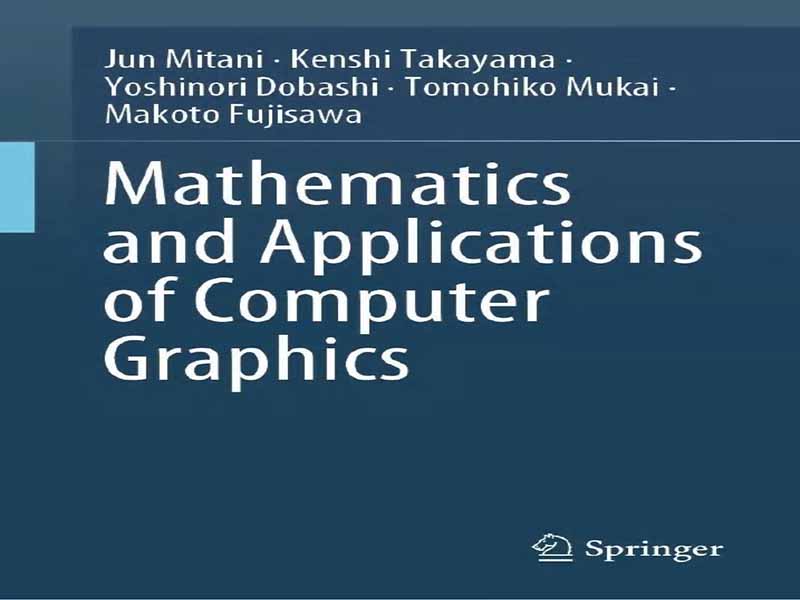- عنوان کتاب: Mathematics and Applications of Computer Graphics
- نویسنده: Jun Mitani · Kenshi Takayama
- حوزه: گرافیک کامپیوتری
- سال انتشار: 2025
- تعداد صفحه: 203
- زبان اصلی: انگلیسی
- نوع فایل: pdf
- حجم فایل: 5.04 مگابایت
گفته میشود که منشأ گرافیک کامپیوتری (CG) به اوایل دهه ۱۹۶۰ برمیگردد، زمانی که ایوان ساترلند، دانشمند کامپیوتر آمریکایی، Sketchpad را اختراع کرد که پیش درآمد رابط کاربری گرافیکی (GUI) بود. برای مدت طولانی پس از آن، کامپیوترها در درجه اول برای محاسبات علمی و فنی و کارهای اداری استفاده میشدند. با این حال، با ظهور رایانههای شخصی و کنسولهای بازی که در زندگی روزمره ما مورد استفاده قرار میگیرند، طیف گستردهای از برنامهها برای اهداف سرگرمی توسعه یافتهاند. با بهبود عملکرد کامپیوتر و افزایش تقاضا برای ایجاد تصاویر به گونهای که گویی دنیای واقعی روی صفحه نمایش در حال گسترش است، CG سهبعدی به یک فناوری ضروری تبدیل شد. امروزه، خدمات مختلفی مبتنی بر CG سهبعدی در بازیها، فیلمها، تبلیغات، تجربیات VR و موارد دیگر متولد شدهاند. علاوه بر این، با ظهور نمایشگرهای نصب شده روی سر، طیف برنامهها به دلیل امکان تجربیات غوطهورکننده گسترش یافته است. بیش از ۶۰ سال پس از تولد CG، کامپیوترها به پیشرفتهای چشمگیری در عملکرد دست یافتهاند که در آن زمان غیرقابل تصور بود و با توسعه فناوری CG سهبعدی، تصاویری با چنان واقعگرایی که از صحنههای زنده قابل تشخیص نیستند، اکنون میتوانند تقریباً به صورت بلادرنگ تولید شوند. واقعیت مجازی، فضای مجازی، فضای مجازی، متاورس، دنیای موازی و غیره، اصطلاحاتی که نشاندهنده فعالیتها در فضاهای مجازی ایجاد شده توسط رایانهها هستند، یکی پس از دیگری ظاهر شدهاند و چالش ایجاد دنیایی جدید با CG سهبعدی هیچ نشانهای از توقف ندارد. شاید انسانها ذاتاً تمایل دارند فضایی جدید را با دستان خود خلق کنند که شبیه به فضایی باشد که در آن زندگی میکنند. در این صورت، CG سهبعدی تا رسیدن به این هدف به تکامل خود ادامه خواهد داد و در آینده نیز به طور جهانی مورد نیاز خواهد بود. اکنون، چنین فناوری CG سهبعدی یک شبه ظاهر نشده است. در طول یک دوره طولانی از تولد گرافیک کامپیوتری، انباشت مداومی از توسعه فنی وجود داشته است. اکنون ما در حال برداشت ثمرات آن تلاش هستیم. با این حال، اگر میخواهید بر فناوری CG سهبعدی مسلط شوید و در توسعه آن مشارکت کنید، باید فناوری زیربنایی آن را درک کنید. برای برآوردن این نیاز، این کتاب نوشته شده است. این کتاب فناوریهایی را که از 3DCG پشتیبانی میکنند، توضیح میدهد و به چهار فصل تقسیم شده است: «پردازش هندسه با مشهای سطحی»، «رندرینگ»، «انیمیشن شخصیت» و «شبیهسازی فیزیک». هر یک از این موارد در یک فصل جداگانه توضیح داده شده است. اگر بخواهیم این چهار فناوری را به زبان سادهتر بیان کنیم، میتوانیم بگوییم که آنها در مورد ایجاد اشکال، ایجاد تصاویر، ایجاد حرکات و بازتولید رفتار دنیای طبیعی هستند. در فصل 1 (نوشته شده توسط کنشی تاکایاما)، نظریههای توصیف شکل یک شیء با مش سطحی و ویرایش و پردازش آن را توضیح میدهیم. در فصل 2 (نوشته شده توسط یوشینوری دوباشی)، بر محاسبه ظاهر سطح شیء تمرکز میکنیم و روشهای محاسبه روشنایی سراسری برای تولید تصاویر واقعگرایانه، روشهای تولید سریع تصویر با استفاده از پیشمحاسبه و پدیدههای فیزیکی مانند پراکندگی نور لازم برای بهبود واقعگرایی را توضیح میدهیم. در فصل … در فصل ۳ (نوشتهی توموهیکو موکایی)، روش اسکلت، یک تکنیک استاندارد در تولید انیمیشن، را معرفی میکنیم و تکنیکهای مختلف ویرایش انیمیشن را برای مدلهای شخصیت انساننما توضیح میدهیم. در نهایت، در فصل ۴ (نوشتهی ماکوتو فوجیساوا)، روشهایی را برای محاسبهی رفتار پدیدههای طبیعی پیچیده، شامل نه تنها اشیاء صلب، بلکه سیالاتی مانند آب و هوا، توضیح میدهیم. میتوان گفت چهار موضوعی که در اینجا ذکر شدهاند، عناصر اساسی پشتیبانیکنندهی ۳DCG هستند. هر فصل توسط محققانی نوشته شده است که در خط مقدم هر زمینه فعال هستند. همه نویسندگان دستاوردهای قابل توجهی دارند و با تجربه و دانش فراوان خود، توسعهی فناوری ۳DCG را رهبری میکنند. محتوای پوشش داده شده در این کتاب، اصول اولیهی ۳DCG است، اما این بدان معنا نیست که ساده است. در مقایسه با کتابهای مشابه، حاوی محتوای پیشرفتهی ریاضی است. به طور خاص، دانش پایه در مورد آنالیز و جبر خطی، که در دورههای علوم و مهندسی دانشگاه تدریس میشود، مورد نیاز است. همچنین، دانش پایه در مورد مکانیک محیطهای پیوسته و مکانیک سیالات و دانش بهینهسازی ریاضی مانند روش حداقل مربعات، خواندن آن را آسانتر میکند. بنابراین، خوانندگان اصلی این کتاب دانشجویان سال آخر رشتههای علوم و مهندسی یا دانشجویان تحصیلات تکمیلی هستند. این کتاب همچنین برای طیف وسیعی از افراد، از جمله دانشآموزان دبیرستانی و متخصصان علاقهمند به نظریه گرافیک کامپیوتری سهبعدی، مهندسان شاغل در شرکتهای توسعه بازی و کسانی که گرافیک کامپیوتری سهبعدی را به عنوان یک موضوع تحقیقاتی در نظر میگیرند، توصیه میشود. امیدواریم این کتاب در درک فناوریهایی که از 3DCG پشتیبانی میکنند، مفید باشد.
It is said that the origin of computer graphics (CG) dates back to the early 1960s when Ivan Sutherland, an American computer scientist, invented Sketchpad, which was a precursor to the graphical user interface (GUI). For a long time thereafter, computers were primarily used for scientific and technical calculations and back-office tasks. However, with the advent of personal computers and gaming consoles being used in our daily lives, a wide range of applications for entertainment purposes have been developed. As computer performance improved and the demand for creating images as if the real world was expanding on the screen increased, 3D CG became an indispensable technology. Today, various services based on 3D CG have been born in games, movies, advertisements, VR experiences, and more. Furthermore, with the advent of head-mounted displays, the range of applications has expanded due to the possibility of immersive experiences. More than 60 years after the birth of CG, computers have achieved dramatic performance improvements that would have been unimaginable at the time, and with the development of 3D CG technology, images with such realism that they are indistinguishable from live-action can now be generated almost in real time. Virtual reality, virtual space, cyberspace, metaverse, parallel world, and so on, terms representing activities in virtual spaces created by computers have appeared one after another, and the challenge to create a new world with 3D CG shows no signs of stopping. Perhaps humans inherently have a desire to create a new space with their own hands that is similar to the space they live in. If so, 3D CG will continue to evolve until that is achieved and will continue to be universally needed in the future. Now, such 3D CG technology did not appear overnight. There was a steady accumulation of technical development over a long period from the birth of computer graphics. We are now reaping the fruits of that effort. However, if you want to master 3D CG technology and contribute to its development, you need to understand the underlying technology. To meet this need, this book was written. This book explains the technologies that support 3DCG, divided into four chapters: “Geometry Processing with Surface Meshes,” “Rendering,” “Character Animation,” and “Physics Simulation.” Each of these is explained in a separate chapter. If we were to express these four technologies in simpler terms, we could say they are about creating shapes, creating images, creating movements, and reproducing the behavior of the natural world. In Chap. 1 (authored by Kenshi Takayama), we explain the theories for describing the shape of an object with a surface mesh and editing and processing it. In Chap. 2 (authored by Yoshinori Dobashi), we focus on the calculation of the appearance of the object’s surface and explain global illumination calculation methods for generating realistic images, fast image generation methods using pre-calculation, and physical phenomena such as light scattering necessary for improving realism. In Chap. 3 (authored by Tomohiko Mukai), we introduce the skeleton method, a standard technique in animation production, and explain various animation editing techniques for humanoid character models. Finally, in Chap. 4 (authored by Makoto Fujisawa), we explain methods for calculating the behavior of complex natural phenomena, including not only rigid objects but also fluid like water and air. The four themes mentioned here can indeed be said to be the fundamental elements that support 3DCG. Each chapter was written by researchers who are active at the forefront of each field. All the authors have remarkable achievements and are leading the development of 3DCG technology with their abundant experience and knowledge. The content covered in this book is the basics of 3DCG, but that does not mean it is simple. Compared to similar books, it contains mathematically advanced content. Specifically, basic knowledge of analysis and linear algebra, which is taught in college science and engineering courses, is required. Also, basic knowledge of continuum mechanics and fluid mechanics, and knowledge of mathematical optimization such as least squares method would make it easier to read. Therefore, the main target readers of this book are senior students in science and engineering courses or graduate students. This book is also recommended for a wide range of people, including high school students and professionals interested in the theory behind 3D computer graphics, engineers working at game development companies, and those considering 3D computer graphics as a research subject. We hope this book will be useful in understanding the technologies that support 3DCG.
این کتاب را میتوانید از لینک زیر بصورت رایگان دانلود کنید:




































نظرات کاربران